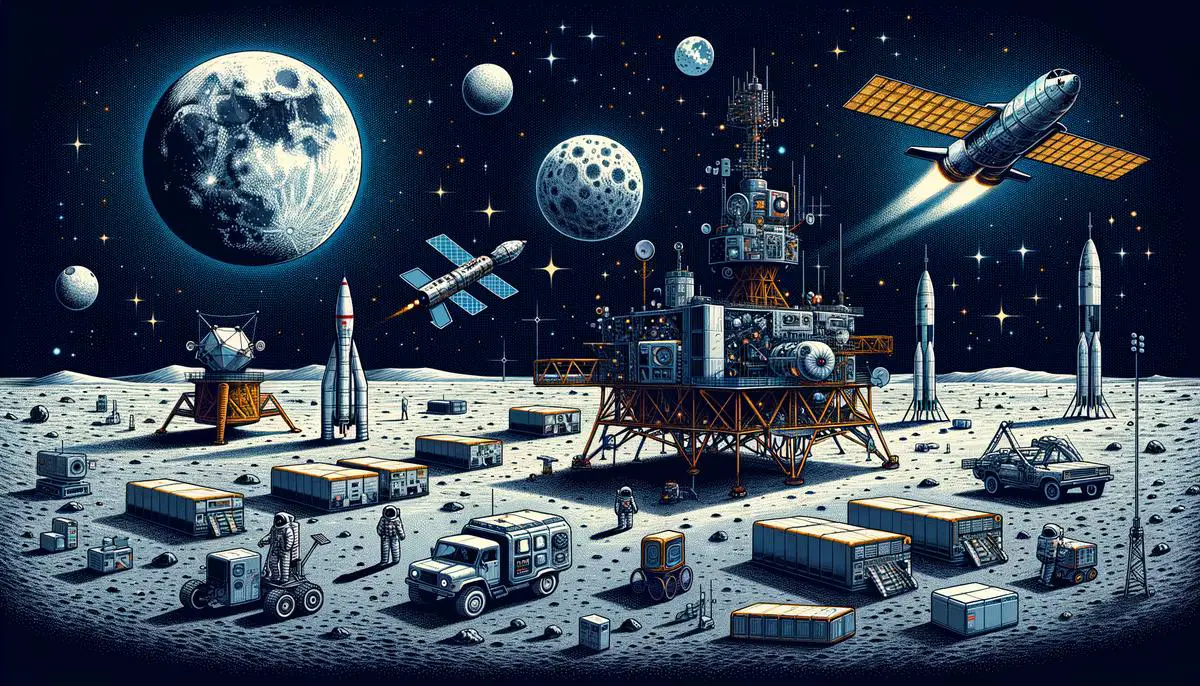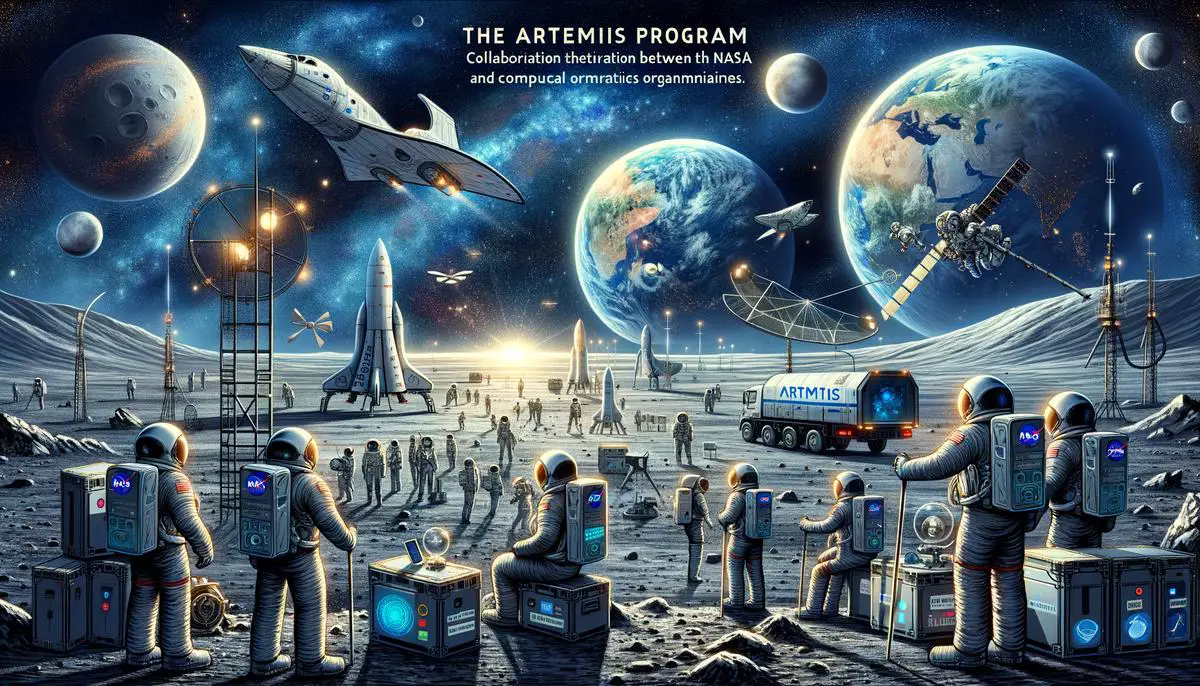The Artemis Program is setting the stage for a monumental shift in how we approach space exploration, with ambitions that stretch from the Moon to Mars. It’s about more than just visiting these celestial bodies; the goal is to establish a sustainable human presence, demanding solutions to a host of technical, scientific, and logistical challenges. This article aims to unpack the complexities and the collaborative spirit fueling this venture, showcasing the innovations aimed at making life beyond Earth a reality and highlighting the role of international partnerships and commercial participation in this bold endeavor.
Contents
Technical Challenges and Innovations
NASA’s Artemis Program is gearing up to return humans to the Moon and set the stage for future manned missions to Mars. This ambitious undertaking isn’t just about revisiting Earth’s satellite; it aims to establish a sustainable human presence on the Moon by the end of the decade. Achieving these goals requires overcoming significant technical challenges and harnessing innovative technologies.
One major technical hurdle is developing the Space Launch System (SLS), which is the most powerful rocket ever built. The SLS will propel astronauts aboard the Orion spacecraft beyond Earth’s orbit, carrying humans farther into space than ever before. However, designing a rocket with such unprecedented power and ensuring its reliability and safety for crewed missions has proven to be a daunting task. Challenges include managing the immense forces during liftoff and flight, ensuring the structural integrity of the rocket, and achieving the precision needed for lunar orbit insertion and landing trajectories.
Another technical challenge is creating habitats and life-support systems that can sustain astronauts on the lunar surface. Unlike the brief Apollo missions, Artemis aims for longer stays, necessitating advancements in life support systems. These systems must efficiently recycle air and water while managing waste products in a closed-loop system to support astronauts for extended periods without resupply from Earth. Developing robust habitats that can protect astronauts from the Moon’s harsh environment, including extreme temperature fluctuations, radiation, and micrometeoroid impacts, is critical.
Lunar surface mobility is another area requiring innovative solutions. Artemis astronauts will need to travel more extensively across the Moon’s surface than Apollo astronauts did. This demands the development of new types of vehicles that can navigate the rugged lunar terrain. These vehicles must be reliable, capable of covering vast distances, and equipped with life-support systems for long-duration excursions. NASA is exploring concepts for pressurized rovers that would allow astronauts to explore in their regular clothes without the need for spacesuits.
Innovations in spacesuit design are also crucial to the success of the Artemis Program. NASA is developing the next generation of spacesuits that offer greater mobility and flexibility, allowing astronauts to perform complex tasks on the lunar surface. These suits must also provide protection against the Moon’s extreme temperatures, harmful radiation, and micrometeoroids.
Finally, the Artemis program relies on establishing a Gateway in lunar orbit. This outpost will serve as a multi-purpose hub for deep space exploration, offering a staging point for lunar landings, a laboratory for scientific research, and a platform for missions to Mars. Developing the Gateway poses its own set of challenges, including the need for modular design for incremental growth, life-support systems for crewed missions, and the capability to support both robotic and crewed landers.
The Artemis Program represents a leap forward in space exploration, requiring a complex interplay of technologies and innovations to overcome its many challenges. From the power and reliability of the SLS to the development of sustainable life support systems and the creation of a lunar Gateway, each component is crucial for establishing a human presence on the Moon and laying the groundwork for the next giant leap to Mars.

Collaboration and Global Partnerships
International collaborations play a crucial role in the success and advancement of NASA’s Artemis Program. This ambitious initiative isn’t just an American endeavor; it represents a global effort, drawing on the expertise, resources, and innovative technologies from countries and space agencies around the world. The Artemis Program’s far-reaching goals require an unprecedented level of cooperation and partnership to make the dream of returning to the Moon and venturing beyond a shared reality for humanity.
The International Space Station (ISS) serves as a prime example of what global collaboration in space exploration can achieve. Building on this foundation, the Artemis Program extends the spirit of international cooperation to lunar exploration. Countries such as Canada, Japan, the European Union, and others are contributing in significant ways. Their involvement ranges from providing vital hardware for the Gateway, developing rovers for lunar exploration, to advancing the technologies needed for extended human and robotic presence on the Moon.
Canada, for instance, is developing the next-generation robotic arm, known as Canadarm3 for the Gateway. This essential piece of technology builds upon Canada’s history of robotics innovation in space and will play a critical role in the Gateway’s construction, maintenance, and operation. Similarly, the European Space Agency (ESA) is contributing key components like the ESPRIT communication and refueling module and the International Habitation module (I-Hab), which will offer living and working space for astronauts.
Japan’s space agency, JAXA, is not only contributing to the Gateway’s technological needs but is also focusing on lunar surface exploration. JAXA plans to develop pressurized lunar rovers that will significantly enhance human mobility on the Moon’s surface, allowing astronauts to explore farther and more safely than ever before.
These international contributions are not just about hardware and technology; they’re about sharing the vision of space exploration and pooling global resources and intellect for a common goal. The collaborative nature of the Artemis Program ensures a more sustainable, long-term presence on the Moon while setting the stage for future missions to Mars and beyond.
Furthermore, the Artemis Accords, a series of bilateral agreements between the United States and partner nations, underscore the commitment to peaceful, transparent, and responsible activities on the Moon. These accords align international efforts under a common set of principles, ensuring activities on the Moon benefit all of humanity and protect the celestial heritage and space resources.
The success of the Artemis Program and its ambitious goals hinges on these international partnerships. By working together, countries and space agencies can pool their resources, share the risks and costs, and maximize the scientific, technological, and exploration benefits. The collaborative approach fosters innovation, accelerates technological development, and paves the way for humankind’s next giant leap in space exploration.
In essence, international collaborations are not just shaping the trajectory of the Artemis Program; they are ensuring its success and enabling a new era of exploration where humanity, as a collective, reaches new frontiers. This global endeavor transcends individual ambitions and represents a united effort to explore, discover, and expand our presence in the cosmos.

Scientific Objectives and Research Opportunities
The Artemis Program, led by NASA, is an ambitious venture aiming to achieve more than just returning humans to the Moon’s surface. At its core, the program is designed to unlock a myriad of scientific objectives and research opportunities that promise to advance our understanding of the Moon, the Solar System, and beyond. This profound exploration effort seeks to utilize the Moon’s unique environment for groundbreaking scientific research, thereby setting the stage for future human and robotic missions to Mars and other destinations.
Scientific Objectives Behind Returning to the Moon
One of the paramount scientific objectives of the Artemis Program is to conduct detailed studies on the Moon’s composition. Despite previous missions, vast regions of the Moon, especially the South Pole, remain largely unexplored. This area is of specific interest because it is believed to hold water ice, a critical resource that could potentially support future lunar bases by providing water for astronauts and fuel for spacecraft. Understanding the distribution and amount of water ice could revolutionize how we approach long-term human habitation on the Moon and in space.
In addition to the quest for water, Artemis aims to broaden our geological knowledge of the Moon. By analyzing the Moon’s surface and subsurface, scientists hope to uncover insights into its formation and evolution. These efforts will not only provide a better understanding of the Moon itself but also offer clues about the early history of the Earth and the Solar System. The lunar samples brought back by Apollo astronauts have already revolutionized our understanding of the cosmos; Artemis promises to take this research to new heights with advanced technology and methodologies.
Research Opportunities Enabled by the Artemis Program
Apart from geological studies, the Artemis Program is poised to create opportunities for research in fields such as astrophysics and heliophysics. The Moon’s far side, shielded from the Earth’s electromagnetic interference, offers an unparalleled environment for radio astronomy. Plans are underway to utilize this unique advantage to study the universe at wavelengths that are impossible to observe from Earth. This could lead to significant advancements in our understanding of the cosmic dawn, the early universe, and the nature of exotic cosmic phenomena.
Another key research area focuses on understanding space weather and its implications for future space exploration. The Artemis Program plans to deploy instruments to study the Sun’s interactions with the lunar surface, providing critical data on the radiation environment in space. This research is essential for developing protective measures for astronauts and electronic equipment on future deep space missions.
Leveraging the Moon for Broader Scientific Advancements
Furthermore, the Artemis Program endeavors to transform the Moon into a platform for science that extends its reach beyond lunar-focused objectives. By establishing a sustainable human presence and infrastructure on the Moon, including the Gateway, NASA aims to facilitate research that could address some of humanity’s most pressing scientific questions. This includes experiments in life sciences to study the effects of prolonged exposure to the microgravity environment, an area crucial for the long-term success of human exploration of Mars and other destinations.
Engaging in resource utilization studies is another significant aspect of Artemis’s scientific agenda. Learning to harness and utilize the Moon’s resources effectively could pave the way for self-sustaining lunar bases, reducing the reliance on resources launched from Earth. This capability is critical for the feasibility of prolonged human presence on the Moon and for missions farther into the solar system.
In essence, the Artemis Program represents a bold step forward in space exploration, with scientific inquiry at its heart. Through a combination of human and robotic missions, Artemis will provide unparalleled opportunities for scientific research that will deepen our understanding of the Moon, our solar system, and the wider universe. As humanity stands on the precipice of this new era of discovery, the insights gained from the Artemis Program will undoubtedly shape our future in space for generations to come.

Economic Implications and Commercial Participation
Now, shifting our focus to the economic sphere, the Artemis Program is not just a monumental stride in cosmic exploration but a beacon for economic revolution, spotlighting the indispensable role of commercial entities. As nations rally to etch their mark on the lunar surface and beyond, the blueprint of space exploration is being redrawn, with public-private partnerships as its cornerstone.
Central to the Artemis Program’s mission is the enlistment of commercial companies. This collaboration is paramount, as it transcends beyond merely outsourcing tasks; it’s about embedding the commercial sector into the very fabric of space exploration. The infusion of private investment into this cosmic quest brings to the table not just capital but innovation, agility, and the potential to lower costs through competitive dynamics. In other words, the harnessing of commercial acumen and resources is crucial for the Artemis Program to attain its lofty objectives.
Commercial entities are participating in diverse roles, ranging from the development of launch services to the creation of lunar landers. Take, for instance, the Human Landing System (HLS), where companies like SpaceX have been selected to develop human landing systems for the Artemis missions. This is not just a contract; it signals a shift towards a new epoch where governmental space agencies and private firms are co-pilots in the journey of space exploration.
Moreover, the economic implications extend well beyond the confines of Artemis missions. The proliferation of space infrastructure, necessitated by missions like Artemis, provides a fertile ground for commercial activities in space – from resource mining to space tourism. The moon’s potential as a waypoint for farther cosmic voyages or as a site for harvesting vital resources can spur an entire economy orbiting around lunar and space endeavors.
The role of commercial entities also aligns with the goal to establish a sustainable human presence on the moon. By encouraging private companies to innovate and invest in lunar bases, life support systems, and other essential infrastructure, the Artemis Program is paving the way for the moon to become not just a site of exploration but an arena for commerce and human expansion.
Fostering an ecosystem where NASA, alongside other space agencies, partners with a fleet of companies, does more than accelerate the pace of space exploration. It democratizes space, making it a realm within reach for entities beyond the traditional governmental and academic institutions. The competitive, as well as collaborative dynamics among businesses, can propel technological leaps, drive down costs, and unleash a wave of economic and scientific opportunities.
In essence, the Artemis Program envisions a future where the moon serves as a new frontier not just for explorers but for entrepreneurs and visionaries. The merging of governmental vision and commercial vigor charts a course towards a sustainable and economically vibrant ecosystem in space. This partnership paradigm may well be the most defining legacy of the Artemis Program, signaling a new dawn in human enterprise and cosmic ambition.

The Artemis Program epitomizes humanity’s unyielding quest for knowledge and the innate desire to push the boundaries of what’s possible. Through a symphony of global partnership, technical prowess, and scientific inquiry, it represents not just a leap towards establishing a human presence on the Moon and beyond but a testament to our collective resolve to overcome obstacles. As we stand on the precipice of this new era in space exploration, the Artemis Program is a beacon of hope and a blueprint for future generations, illuminating the path toward an expanded human presence in the cosmos. The achievements and discoveries we stand to gain promise to enrich our understanding of the universe and inspire countless individuals to dream of a future among the stars.
